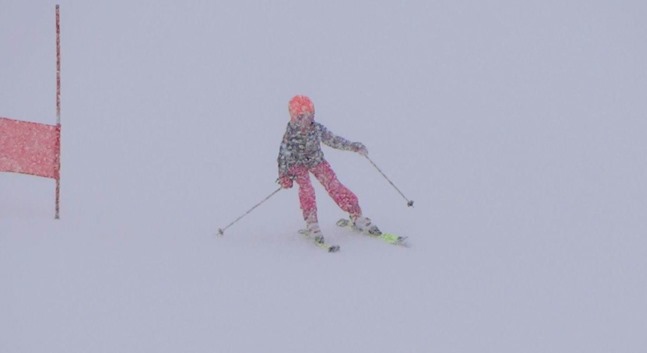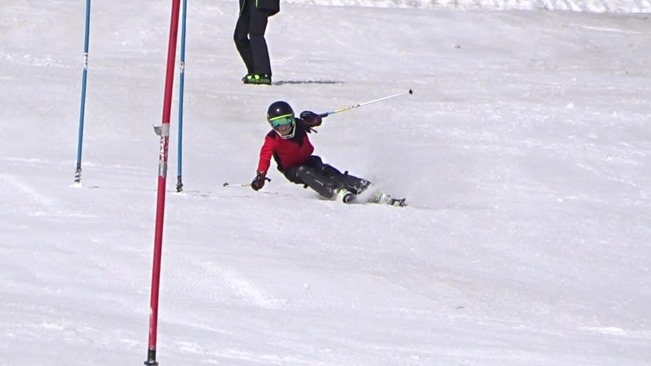Final day for Derin but unfortunately the afternoon brought bad weather. The slalom training was not available and the snowfall became progressively heavier as time progressed. Fresh snow was also distracting Derin from making technical progress so for the most part we just ended up skiing and trying to make the most of her last session. There was still some work done on technique and it will all contribute but today there was more to be gained just by skiing than by trying to tackle the intricacies of technique.
Slalom
It appears that Derin had already understood the “line” in slalom but that she just couldn’t manage to do it. Technically her skiing is good enough to manage it so the obvious reason for the difficulty is inexperience. Children tend to head straight for the next pole and then only think about turning when they arrive – making them very late to turn. Although I’d skied the course with Derin behind me to show the line the significance didn’t properly register with her. We worked on creating angulation (bottom facing uphill) to help deal with the technical side of holding a good line but she needed more opportunity and time in the poles to understand the overall context. The same problem exists when cornering in cars or on bikes in race courses – with the line being critical – and this always has to be learned as it does not appear to be an automatic or innate issue. I know from practice that in both mountain biking and road cycling the art of cornering efficiently on descents demands a lot of experience, experimentation and skill – with skiing probably demanding a great deal more. Surprisingly, although understanding the idea of “angulation” Derin still physically made the wrong movement when trying to show it. We have repeated this many times now so it is unusual to see this sort of physical confusion with Derin. Her very wide stance does make this form of hip angulation difficult and this is probably the cause of the issue here. In reality her wide stance creates another form of angulation, laterally from the hip – which is why she still skis relatively well and never once fell over from skiing all week – even in the race course. Eventually we have to change her wide stance for a more evolved narrower stance with angulation created through the orientation of the pelvis (facing the bottom uphill). The reason for this requirement is to limit issues that can arise from body rotation – which will become apparent as she skis faster and holds a better line in slalom and elsewhere. (Work on the pivot and on skating were aimed at improving her overall stance – both concerning width and fore-aft issues) Video: Carving and “one leg pivot” practise.
Pivoting
Derin has understood how to use the edges of the feet and skis in pivoting – or at least appears to understand for some aspects. You always keep both feet on their inside edges – inside the ski boots. When pivoting from the uphill ski you stand up on the ski, roll the foot properly on its inside edge (downhill) and keep the ski itself on its uphill edge (through the lateral stiffness of the shaft of the ski boot). This permits the ski to freely pivot into the turn – the front sideslipping into the turn. The ski changes edge half way through but the foot always remains on its inside edge. When pivoting from the downhill ski you stand up on the ski, roll the foot properly on its inside edge (uphill) and keep the ski on its uphill edge. (through the lateral stiffness of the shaft of the ski boot). This permits the ski to freely pivot into the turn – the front sideslipping into the turn. The ski changes edge half way through but the foot always remains on its inside edge.
In both cases the use of the ski pole for support is critical and this is where Derin struggles. She is not comforatable allowing weight onto her ski pole and using the strength in her arms. This pole use is to hold the weight (centre of mass) for a short while in the right location for pulling the ski into its sideslipping action. In reality it’s the only time ski poles are actively used for skiing – in this “braking” pivoted turn where there is almost no forward motion of the ski. In 1992 in the USA the teaching system banned “pole planting” because it made no sense. During my training in the UK system I’d been questioned about the use of pole in teaching and responded that it made no sense to me – to which the examiners agreed. “Pole Planting” only makes sense specifically when pivoting. Please note – the French still teach in general to “up – come around – down and then pole plant”. It’s just wrong – as is that entire timing. The US now use a “pole touch” which happens as the body falls into the next turn – due to the body moving over (dynamics) and this is correct. For the pivot – the pole supports the body strongly when entering into that new turn and this can be seen as a real and effective “pole plant”. None of the above systems properly understand this distinction. Derin just needs time and peristence to learn to trust the pole to help guide the body – to then direct the skis – in the pivot. Currently her struggle with the pivot is due to the body not being in the right place and moving into the centre of the turn. She was very close to getting it and had the weather been better she may have managed properly today. When skiing with forward speed then the skis generate forces when placed on edge and so dynamics takes over – hence no requirement for the supportive pole plant – then the “pole touch” is only for feedback. Derin loves the snow! 
Carving
We only had one run of carving as visibility was not too good and the snow was very soft on the surface. Regardless of this Derin shows a clear feeling for railing along on her edges.
Arms
The arms are a very visible aspect of skiing but often not very significant. It’s common for instructors to fixate on the arms until clients are rigid with their hands stuck out in front – but nothing else working. Please ignore any comments about hands and arms regarding Derin. Derin, when relaxed, holds her elbows in. She does this even when not skiing. Let’s just say that Derin is a “real” girl. There is absolutely no gender confusion here. It is natural for women to have the elbows slightly inwards. Men are the opposite beause it makes them better at throwing rocks. There are also postural issues connected to this arm position and Derin likes to hollow her lower back. This is also a typical feminine posture and the reason why adult women wear high heeled shoes. When attacking on her skis that all disappears – so she has absolutely no problems.
Watching Derin even in her first attempts at slalom you can see that her arms go naturally into the appropriate shape when attacking. You don’t cure skiing problems by re-arranging the arms – you cure arm problems by re-arranging the skiing. When Derin gets onto more advanced dynamics the arms will be placed naturally by reflex. It’s important to avoid confusing cause and effect – and important that she is not nagged by anyone about her arms – otherwise she will end up skiing in a straightjacket and will still be in the back of her boots.
Derin has never been criticised by me for being in the backs of her boots – because she has not been old enough to really understand advanced dynamics. It’s sufficient at this stage that when she attacks – as in slalom – she naturally comes off the backs – and that is exactly what happens. I often see the entire children’s group of the Tignes Club des Sports racing team – every single one on the backs of their boots far more than Derin ever did, following their racing coach.  When she can ski like Alex – age 11 here (after only 7 weeks skiing in his life and no comments ever on his arms) – then we will see what her arms do…
When she can ski like Alex – age 11 here (after only 7 weeks skiing in his life and no comments ever on his arms) – then we will see what her arms do…  Ted Ligety – world No 1
Ted Ligety – world No 1 

